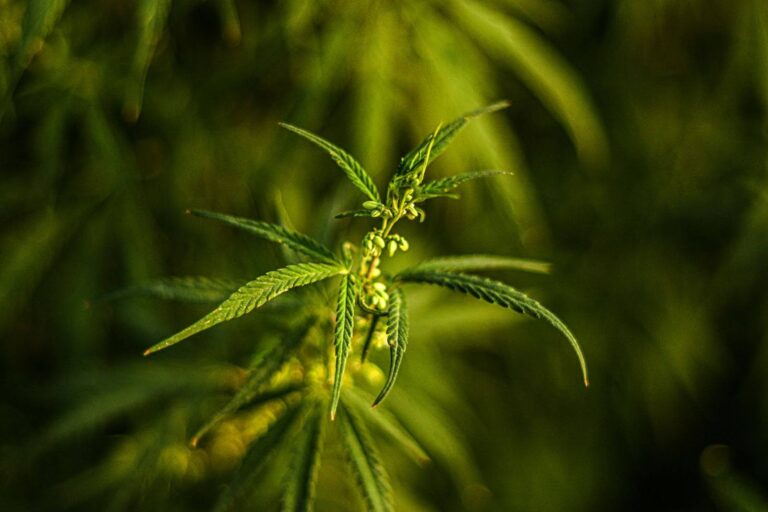Are your cannabis plants not growing as fast or as healthy as you expected? The right nutrients can make all the difference. Without them, you risk weak stems, small buds, and disappointing yields. If you want strong growth and top-quality flowers, understanding the best MMJ nutrients is essential.
Providing the right balance of nutrients not only helps plants grow faster but also strengthens their resistance to pests and diseases. A well-fed cannabis plant will develop thick, lush foliage in the vegetative stage and produce dense, potent buds during flowering.
In this guide, you will learn why nutrients are crucial for cannabis cultivation, which essential nutrients your plants need, and how to choose the best ones for each growth stage. We will also cover nutrient application strategies and recommend some of the top brands trusted by growers.
Why Nutrients Matter in Cannabis Cultivation
Nutrients are the foundation of healthy, high-yielding cannabis plants. Without the right balance, your plants struggle to grow, produce, and resist stress. Here’s why they matter:
- They Fuel Growth & Yield: Macronutrients like nitrogen, phosphorus, and potassium drive leaf, root, and bud development. Without them, plants become weak, and yields suffer.
- They Strengthen Immunity: A well-fed plant is more resistant to pests, mold, and diseases. Nutrients like potassium help fortify cell walls, making plants tougher against threats.
- They Support Root Health & Water Uptake: Phosphorus is key for root development, ensuring efficient nutrient absorption and water uptake. Strong roots mean stronger plants.
- They Boost Potency & Flavor: Cannabinoids and terpenes—the compounds behind cannabis effects and aroma—depend on proper nutrition. The right nutrients enhance potency, flavor, and overall quality.
- They Optimize Growth Speed & Efficiency: Well-balanced nutrition leads to faster vegging, efficient flowering, and more frequent harvests, maximizing productivity for both home and commercial growers.
- They Prevent Deficiencies & Toxicity: Nutrient imbalances cause problems—deficiencies stunt growth, while overfeeding leads to nutrient burn. Proper feeding ensures plants get what they need without excess.
- They Impact Post-Harvest Quality: Even after harvest, nutrient levels affect curing and final bud quality. A well-fed plant produces smoother smoke and better flavor.
So, what nutrients are essential for your cannabis plants? Let us find out.
Essential Nutrients for Cannabis
There are three primary nutrients, also known as macronutrients, that cannabis plants rely on to support their overall health, growth, and productivity. Each of these plays a unique role in different stages of development, ensuring that cannabis plants remain strong, resilient, and capable of producing high-quality yields with perfect NPK ratios.
1. Nitrogen (N) – The Growth Booster
Nitrogen is crucial during the vegetative stage. It helps your plants develop lush, green foliage and strong stems, setting the foundation for healthy growth. Without enough nitrogen, leaves may turn yellow, and growth will slow down, leading to weak plants that struggle to transition into flowering.
2. Phosphorus (P) – The Root and Bud Developer
Phosphorus is needed for strong root development and bud formation. It plays a vital role in energy transfer within the plant, ensuring it has the strength to grow efficiently. A lack of phosphorus can cause slow growth, weak root systems, and underdeveloped flowers.
3. Potassium (K) – The Health Protector
Potassium supports overall plant health by strengthening cell walls and improving disease resistance. It also regulates water intake, which is crucial for healthy growth. Plants lacking potassium may show signs of weak stems, curling leaves, and lower resistance to stressors like drought or pests.
Other Important Nutrients
While nitrogen, phosphorus, and potassium are the primary nutrients, cannabis also benefits from secondary nutrients and micronutrients:
- Calcium (Ca): Strengthens cell walls and helps with nutrient absorption. It also prevents common issues like blossom-end rot and tip burn.
- Magnesium (Mg): A key component of chlorophyll, aiding in photosynthesis. Without sufficient magnesium, leaves may turn yellow, and photosynthesis efficiency will decline.
- Sulfur (S): Supports enzyme functions and overall plant metabolism. It also contributes to the development of terpenes, which influence the aroma and flavor of cannabis.
- Iron (Fe): Essential for chlorophyll production and energy transfer within the plant.
- Zinc (Zn): Helps with leaf formation and stem elongation.
- Boron (B): Plays a key role in cell division and plant growth, supporting healthy bud formation.
- Manganese (Mn): Aids in nitrogen utilization and overall enzyme activation.
Now, let us discuss the nutrients required for the cannabis vegetative stage.
Best Nutrients for the Cannabis Vegetative Stage
During the vegetative stage, your cannabis plants focus on growing strong roots, thick stems, and lush, green foliage. This period sets the foundation for high yields later, so getting the right nutrients is crucial. Here are the key nutrients your plants need during veg and why they matter:
1. Nitrogen (N) – The Primary Growth Driver
- Why? Nitrogen is the most essential nutrient for vegetative growth because it helps produce chlorophyll, the compound responsible for photosynthesis. It fuels the development of leaves and stems, allowing your plant to grow bigger and bushier. A high nitrogen intake ensures your plant builds a strong foundation before entering the flowering stage.
- Sources: Organic options include blood meal, fish emulsion, bat guano, and composted manure. For synthetic options, look for fertilizers with a higher nitrogen ratio, such as 3-1-2 or 4-2-3 formulas.
2. Phosphorus (P) – Root Development & Energy Transfer
- Why? While phosphorus is more critical during the flowering stage, it still plays an essential role in veg by supporting root development and strengthening the plant’s ability to absorb water and nutrients.
A healthy root system ensures the plant can sustain rapid growth. Additionally, phosphorus is needed for ATP (adenosine triphosphate), the energy currency of cells, which powers all biological functions.
- Sources: Bone meal, rock phosphate, and mycorrhizal fungi enhance phosphorus availability in organic soil. Synthetic fertilizers with a moderate phosphorus ratio can also be used.
3. Potassium (K) – Strength & Stress Resistance
- Why? Potassium regulates water movement within the plant, ensuring proper hydration and nutrient transport. It also strengthens plant cell walls, making plants more resistant to environmental stressors like temperature fluctuations, pests, and diseases. This nutrient prepares the plant for the flowering demands by enhancing overall vigor.
- Sources: Kelp meal, wood ash, potassium sulfate, and liquid potassium supplements.
4. Calcium – Structural Integrity & Disease Prevention
- Why? Calcium plays a vital role in building strong cell walls, which prevents weak stems and leaf deformities. It also helps prevent common issues like calcium deficiency, which can cause curling leaves, stunted growth, and brown spots. A steady calcium supply keeps your plant sturdy enough to support heavy buds later.
- Sources: Dolomite lime, gypsum, crushed eggshells, and calcium-rich liquid fertilizers.
5. Magnesium – Essential for Chlorophyll Production
- Why? Magnesium is at the core of chlorophyll molecules, making it crucial for photosynthesis. Without enough magnesium, your plants won’t be able to process sunlight efficiently, leading to yellowing leaves and slowed growth. Since cannabis plants absorb large amounts of light during the vegetative stage, magnesium maximizes energy production.
- Sources: Epsom salt, dolomite lime, and magnesium sulfate supplements.
6. Silica – Stem & Branch Strength
- Why? Silica (silicon dioxide) isn’t always included in standard nutrient regimens, but is a game-changer for structural strength. It reinforces plant cell walls, making stems and branches more rigid.
This is especially useful for supporting large, heavy buds later in flowering. Silica also helps the plant withstand environmental stress like drought, heat, and pests.
- Sources: Rice hulls, diatomaceous earth, potassium silicate supplements.
7. Micronutrients – Small but Mighty
- Why? Even though cannabis plants need these in trace amounts, micronutrients are essential for enzyme activation, nutrient absorption, and overall plant health.
- Zinc helps with hormone production and new leaf formation.
- Iron is critical for chlorophyll synthesis.
- Manganese aids in nitrogen absorption.
- Boron supports cell wall structure and root growth.
- Copper contributes to enzyme function and metabolic processes.
- Sources: Compost, seaweed extracts, trace mineral supplements, and organic soil amendments.
Here is a table that briefly lays out the nutritional requirements for the cannabis vegetative stage:
Nutrient | Importance | Sources |
Nitrogen (N) | Primary driver of leaf & stem growth, aids photosynthesis | Blood meal, fish emulsion, bat guano, composted manure, synthetic fertilizers (3-1-2, 4-2-3) |
Phosphorus (P) | Supports root development & energy transfer (ATP) | Bone meal, rock phosphate, mycorrhizal fungi, synthetic phosphorus fertilizers |
Potassium (K) | Regulates water movement, strengthens plant cell walls, boosts stress resistance | Kelp meal, wood ash, potassium sulfate, liquid potassium supplements |
Calcium | Builds strong cell walls, prevents deformities & diseases | Dolomite lime, gypsum, crushed eggshells, calcium-rich fertilizers |
Magnesium | Essential for chlorophyll production & efficient photosynthesis | Epsom salt, dolomite lime, magnesium sulfate supplements |
Silica | Strengthens stems & branches, increases stress resistance | Rice hulls, diatomaceous earth, potassium silicate supplements |
Micronutrients | Aid enzyme activation, nutrient absorption, and plant health (Zinc, Iron, Manganese, Boron, Copper) | Compost, seaweed extracts, trace mineral supplements, organic soil amendments |
Optimizing Nutrient Absorption
Even with the perfect nutrient mix, pH levels must be within the right range to ensure proper absorption. Keep your pH between 5.8 and 6.5 for soil and 5.5 and 6.0 for hydroponic systems. If the pH is too high or too low, your plant may suffer from nutrient lockout, leading to deficiencies.
Now, let us understand the nutrient needs for the flowering stage in detail.
Best Nutrients for the Cannabis Flowering Stage
When your cannabis plants hit the flowering stage, their nutrient needs shift to focus on bud development, resin production, and overall yield. Here’s a breakdown of the essential nutrients and additives that will help you maximize your harvest.
1. Phosphorus (P) – Essential for Bud Formation
- Why? Phosphorus is a key player in flower formation, root development, and energy transfer within the plant. It ensures that your buds grow dense and healthy while supporting overall plant vigor. Without enough phosphorus, flowers may develop slowly or appear small and underwhelming.
- Sources: Bat guano, bone meal, PK 13/14 bloom boosters.
2. Potassium (K) – Increases Bud Size & Density
- Why? Potassium plays a crucial role in water regulation, nutrient movement, and enzyme activation. During flowering, it enhances bud weight, density, and overall resistance to disease and environmental stress. A potassium deficiency can lead to weak, airy buds and slow development.
- Sources: Sulfate of potash (SOP), kelp meal, langbeinite.
3. Calcium (Ca) – Strengthens Cell Walls & Bud Structure
- Why? Calcium reinforces plant cell walls, making buds and stems more resistant to breakage. It also prevents issues like bud rot and tip burn, which can compromise yields. A lack of calcium leads to weak stems, slow growth, and deformed flowers.
- Sources: Dolomite lime, gypsum, Cal-Mag supplements.
4. Magnesium (Mg) – Enhances Photosynthesis & Bud Growth
- Why? Magnesium is vital for chlorophyll production and nutrient uptake, which directly influences flower size and quality. Without enough magnesium, plants struggle to produce energy efficiently, leading to pale, discolored leaves and weak bud formation.
- Sources: Epsom salt (magnesium sulfate), Cal-Mag supplements.
5. Sulfur (S) – Boosts Terpene & Resin Production
- Why? Sulfur plays a major role in terpene synthesis, which enhances the aroma and flavor of your buds. It also helps with enzyme activation and protein formation, ensuring that your flowers develop their full potency and scent profile.
- Sources: Gypsum, Epsom salt, fish meal.
6. Silica (Si) – Stem & Branch Strength
- Why? Silica (silicon dioxide) isn’t always included in standard nutrient regimens, but it’s a game-changer for structural strength. It reinforces plant cell walls, making stems and branches more rigid. This is especially useful for supporting large, heavy buds later in flowering. Silica also helps the plant withstand environmental stress like drought, heat, and pests.
- Sources: Rice hulls, diatomaceous earth, potassium silicate supplements.
7. Boron (B) – Aids in Bud Development
- Why? Boron is crucial for flower formation and pollen viability. It helps plants transport sugars and nutrients efficiently, ensuring proper bud development and preventing deformities. Without enough boron, flowers may be small, misshapen, or fail to develop fully.
- Sources: Boron supplements, compost teas.
8. Zinc (Zn) – Supports Growth Hormones
- Why? Zinc plays a key role in hormone production and bud growth regulation. It assists in enzyme function and chlorophyll synthesis, helping plants maintain healthy flower production. Zinc deficiency can cause yellowing leaves and slow flowering.
- Sources: Seaweed extract, organic compost.
9. Iron (Fe) – Helps Chlorophyll Production
- Why? Iron is essential for chlorophyll synthesis, helping plants maintain deep green foliage and optimal photosynthesis. A deficiency can lead to pale, yellowing leaves, reducing the plant’s energy production and overall bud quality.
- Sources: Chelated iron supplements, worm castings.
10. Carbohydrates – Energy for Bigger Buds
- Why? During flowering, plants use a lot of energy. Carbohydrate supplements provide extra fuel for soil microbial life, improving nutrient absorption and increasing bud size. They also enhance terpene production, making flowers more aromatic and flavorful.
- Sources: Molasses, honey, sugar-based bloom boosters.
11. Beneficial Microbes – Enhancing Nutrient Uptake
- Why? Beneficial bacteria and fungi help break down nutrients, making them more available to the plant. Mycorrhizal fungi, for example, improve phosphorus absorption, while trichoderma fungi help fight off root pathogens. These microbes create a healthier root environment and boost overall plant resilience.
- Sources: Mycorrhizae, trichoderma, beneficial bacteria inoculants.
Here is a brief table to help you understand the nutritional requirements for the cannabis flowering stage.
Nutrient | Role in Flowering | Sources |
Phosphorus (P) | Essential for bud formation, root development | Bat guano, bone meal, PK 13/14 bloom boosters |
Potassium (K) | Increases bud size, density, and stress resistance | Sulfate of potash, kelp meal, langbeinite |
Calcium (Ca) | Strengthens cell walls, prevents bud rot | Dolomite lime, gypsum, Cal-Mag supplements |
Magnesium (Mg) | Enhances photosynthesis and bud growth | Epsom salt, Cal-Mag supplements |
Sulfur (S) | Boosts terpene and resin production | Gypsum, Epsom salt, fish meal |
Silica (Si) | Strengthens stems and branches | Rice hulls, diatomaceous earth, potassium silicate |
Boron (B) | Aids in bud development and nutrient transport | Boron supplements, compost teas |
Zinc (Zn) | Supports growth hormones and chlorophyll synthesis | Seaweed extract, organic compost |
Iron (Fe) | Helps chlorophyll production and energy use | Chelated iron supplements, worm castings |
Carbohydrates | Provides energy for bigger buds and terpenes | Molasses, honey, sugar-based bloom boosters |
Beneficial Microbes | Enhances nutrient uptake and root health | Mycorrhizae, trichoderma, beneficial bacteria |
Optimizing Nutrient Absorption
Even with the perfect nutrient mix, your cannabis plants won’t thrive if they can’t absorb what you’re feeding them. Maintaining the correct pH levels is crucial for nutrient uptake during the flowering stage.
- Soil-grown plants: Keep the pH between 6.0–6.5 for optimal absorption of phosphorus, potassium, and micronutrients.
- Hydroponic and coco coir systems: Maintain a pH range of 5.5–6.0 to prevent nutrient lockout.
If the pH drifts too high or too low, your plants may struggle to absorb key nutrients, leading to deficiencies that can stunt bud growth. Tracking pH levels and nutrient adjustments across harvests is key to your long-term success.
PlanaCan helps you generate detailed reports, capturing data on your cultivation decisions and their impact on yield. With everything in one place, you can analyze trends, refine strategies, and continuously improve your results. Reviewing these reports lets you identify what works, avoid past mistakes, and optimize nutrient absorption for bigger, denser, and more potent flowers.
So, how should you effectively apply nutrients to your cannabis plants? Let us discuss this in detail.
How to Apply Nutrients to Cannabis Effectively
Feeding your cannabis plants properly is essential for maximizing growth, yield, and potency. It’s not just about what nutrients you use but also how and when you apply them. Here’s how to do it right.
1. Understand Your Plant’s Nutrient Needs
Cannabis plants require different nutrients at different stages of growth:
- Seedling Stage: Minimal nutrients—too much can burn delicate roots.
- Vegetative Stage: High nitrogen for strong stem and leaf development.
- Flowering Stage: Less nitrogen, more phosphorus and potassium for bud production.
2. Choose the Right Nutrient Type
- Synthetic Nutrients: Fast-acting and precise but require careful dosing to avoid overfeeding. Best for hydroponic and controlled indoor grows.
- Organic Nutrients: Slow-release and improve soil health over time. Ideal for outdoor and soil-based grows.
3. Maintain the Right pH for Nutrient Absorption
pH directly affects how well your plants absorb nutrients:
- Soil grows: Keep pH between 6.0–7.0
- Hydroponics/coco coir: Maintain pH between 5.5–6.5
4. Apply Nutrients Correctly
- Soil Grows: Mix liquid nutrients with water and feed evenly. Avoid oversaturating the soil.
- Hydroponics: Maintain a balanced nutrient solution in the reservoir and regularly monitor pH and EC levels.
- Foliar Feeding: Spray diluted nutrients onto leaves for quick absorption. This is best done early in the morning or late evening to prevent leaf burn.
5. Use Microbes & Beneficial Additives
Introducing beneficial bacteria and fungi, such as mycorrhizae and Trichoderma, helps improve nutrient uptake and root health. These microbes break down organic matter, making nutrients more available to your plants.
6. Follow a Feeding Schedule & Avoid Overfeeding
Stick to a structured feeding plan to prevent over- or underfeeding. Many growers follow a feed-water-feed cycle to avoid nutrient buildup. Always start with a lower dose and adjust based on how your plants respond. Overfeeding can lead to nutrient burn (yellowing or curling leaf tips).
Staying organized is key to a consistent feeding schedule. PlanaCan’s visual timeline helps you plan feedings in advance while managing daily tasks. Its dynamic calendar lets you adjust as needed, ensuring nothing is overlooked and your plants get the right care at the right time.
7. Supplement with Calcium & Magnesium (Cal-Mag)
Cannabis plants often need extra calcium and magnesium, especially in hydroponics or when using filtered water. If you notice deficiencies like yellowing leaves or purple stems, adding a Cal-Mag supplement can help.
8. Adjust for Environmental Factors
Temperature, humidity, and light intensity affect how plants absorb nutrients. If temperatures are high, plants will need more water and a lower nutrient concentration to avoid stress. Therefore, you should adjust your feeding based on environmental conditions.
9. Flush Before Harvest
Before harvesting, flush your plants with plain water for 1–2 weeks to remove excess nutrients. This prevents a harsh or chemical taste in the final product and ensures a smoother smoke.
Recommended Nutrient Brands
Finding the best weed nutrients in 2025 can be overwhelming with so many choices available. With countless products on the market, selecting the right one can significantly affect your plant’s health and yield. To simplify the process, here are some of the top brands growers trust for providing reliable and effective nutrient solutions:
- Advanced Nutrients: A premium choice for all cannabis strains, featuring a self-adjusting pH system that maximizes nutrient absorption and prevents imbalances. It also includes a range of supplements designed to enhance plant health and boost yields.
- Fox Farm: A trusted multiphase nutrient system designed to prevent deficiencies and support plant health from seedling to harvest, ensuring consistent and high-quality yields.
- Dyna-Gro: A highly versatile option suitable for all growing mediums and stages, providing a balanced blend of essential nutrients for optimal growth.
- General Hydroponics: Offers a wide range of customizable nutrient solutions tailored to different growth phases, making it ideal for both beginners and experienced growers.
- Botanicare: Known for its organic-based formulas that not only enhance plant health but also improve soil quality, making it a great choice for sustainable cultivation.
Conclusion
Using the best MMJ nutrients is one of the most important steps in achieving a successful cannabis harvest. Understanding what your plants need and selecting the right fertilizers can boost growth, prevent deficiencies, and maximize yields. Whether you choose a commercial solution or prefer organic alternatives, the right feeding strategy will set your plants up for success.
To further streamline your cannabis cultivation, PlanaCan provides a powerful tool that helps growers maximize their yields and manage their crops efficiently.
PlanaCan simplifies your task scheduling by allowing you to define and automate cultivation processes using customizable templates. Each step of the process, from initial planting to final harvest, can be outlined for specific strains or harvest cycles. Once you create templates, you can schedule tasks onto a calendar with just a few clicks, ensuring a streamlined and consistent workflow.
You also get a clear visual timeline for planning and tracking cultivation tasks, helping you organize work months ahead while managing day-to-day activities. The interactive calendar lets you adjust ongoing tasks as needed, keeping up with dynamic requirements. It centralizes information so that everyone involved can see what needs to be done, ensuring no task is overlooked.
By integrating the right nutrients with a well-organized cultivation plan, you can take your cannabis growing to the next level.
Schedule a free call today to see how PlanaCan can help optimize your workflow and boost your harvests.




